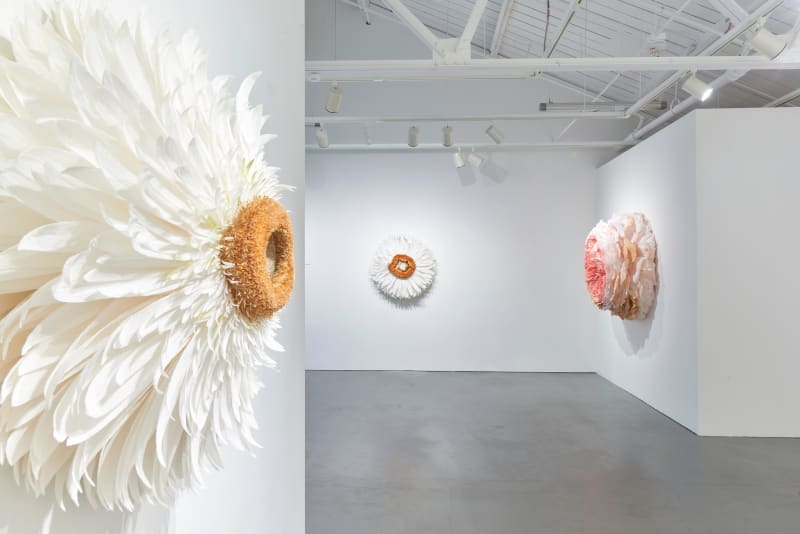Like many women, aging has been on Tiffanie Turner’s mind. The Fairfax resident became more conscious of it after the birth of her second child in 2009, followed by a health scare. “It made me wonder if I was going to have all my facilities for the rest of my life, so I said I need to do something really crazy,” says Turner, who then took up burlesque and performed throughout San Francisco.
After she couldn’t find a good way to make a floral headpiece for a burlesque costume, she made her own style of paper flowers and paved the way to her unexpected career as a botanical sculptor.
Reflections of aging and beauty make its way into her latest solo show, “What Befell Us,” through June 15 at the Eleanor Harwood Gallery in San Francisco. The seven large-scale sculptures of flower heads look imperfect, some missing petals, others dyed with tea to symbolize decay. Yet, to Turner, they are still beautiful.
“Why can’t we learn to see more things as beautiful than having to make things be beautiful?” asks Turner, whose work incorporates Italian crepe paper and other materials.
For gallery owner Eleanor Harwood, the show showcases Turner’s fine art prowess. “It’s pointing to what we think as ugly and making it beautiful and exquisite,” Harwood says. The inspiration for this show came from a large-scale rotting peony Turner showed in a prior group exhibit.
“There were giant, perfect marigold in that show, but this one peony, most people were drawn to it,” she recalls. “The reaction to that piece is what triggered me to think, there’s so much more that can be explored here.”
As a woman in her late 40s, these issues hit home. “There’s a real strong connection with femininity and flowers,” she says. “Even in my own life, how can I bridge the gap of liking my age spots and seeing that as beautiful, when is it going to click for me? Do we all have to be over 50 before we start realizing that there’s more to life than looking gorgeous?”
As with most of her work, these new pieces feature an underlying theme of environmentalism. “It’s hard to find actual environmental blight in the head of a flower,” she says. “I like to superimpose the idea of, consider this ranunculus is rotting because it got too hot too quick.”
Growing up in New Hampshire, Turner found an appreciation for nature although there weren’t many flowers near where she grew up. Her interest in flowers didn’t start until she attended Rensselaer Polytechnic Institute in New York to study architecture, and started painting floral images in her spare time. “I came to this art more from Dutch paintings and things like that, than I did from being in the garden,” says Turner, who showcased some of her botanical paintings when she first came to San Francisco more than two decades ago.
But, art took a backseat to her career as an architect and raising her children. “It was always in the back of my mind how much I loved botany and flowers,” says Turner, still a licensed architect. Her architecture background weaves itself into her work. “We lived in a really austere, cool modern house my parents designed in New Hampshire, and it wasn’t like any other house on the block,” Turner says. “I think a lot of my aesthetic comes from that.
In architecture, too, it’s like why are we just filling the world with things that are so awful because we think that it’s a perfect home?” She first showcased her paper flower sculptures at San Francisco’s Rare Device in 2014. Two years later she received the Zellerbach Family Grant award to support her work as an artist-in-residence at the de Young Museum.
An instructor in the art of paper flower making, she also wrote “The Fine Art of Paper Flowers,” (Ten Speed Press, 2017), her book of tips and tricks to the art of paper flower making.
“Tiffanie Turner’s creations are exquisite,” observes author and editor Dominique Browning in a New York Times book review. “Her DIY instructions for handmade marigolds, roses, dianthus and daffodils are meticulous.”
Turner’s paper flowers are unbelievably lifelike — and that’s the point. “The realism is part of how I feel like people can really attach themselves to it,” she says. Her larger-scale work is meant to show the details of flowers people don’t normally see. “If you are trying to tell a story with a flower, whether it’s ‘is this thing both ugly and pretty to you,’ or what happened to this thing,’ or ‘why is this shaped like this,’ it’s really goodto start with a baseline of a recognizable flower.”
She hopes to have people rethink the idealism of beauty, something she wrestles with. “I am struggling with everybody else to resolve how can I possibly see myself as beautiful and will I ever. But I keep trying,” she says.
“My hope is that they can see that there are imperfections in a different way in each one and that they are still fully beautiful. When you walk out of there, you’re going to be like, there were some rotten flowers there and wasn’t it a beautiful show.”


